trailer PEUGEOT 2008 2016 Owners Manual
[x] Cancel search | Manufacturer: PEUGEOT, Model Year: 2016, Model line: 2008, Model: PEUGEOT 2008 2016Pages: 450, PDF Size: 14.16 MB
Page 5 of 450
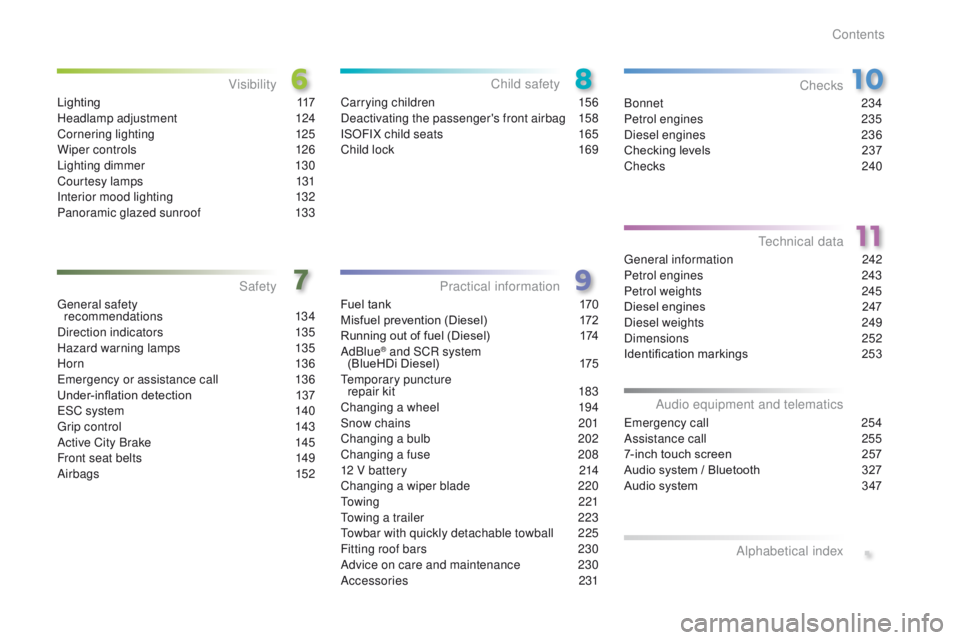
.
2008_en_Chap00a_sommaire_ed01-2016
General safety recommendations 134
Direction indicators
1
35
Hazard warning lamps
1
35
H or n
13
6
Emergency or assistance call
1
36
Under-inflation detection
1
37
ESC system
1
40
Grip control
1
43
Active City Brake
1
45
Front seat belts
1
49
Airbags
152
Safety
Fuel tank 1 70
Misfuel prevention (Diesel) 1 72
Running out of fuel (Diesel)
1
74
AdBlue
® and SCR system
(BlueHDi Diesel) 1 75
Temporary puncture repair kit
1
83
Changing a wheel
1
94
Snow chains
2
01
Changing a bulb
2
02
Changing a fuse
2
08
12 V battery
2
14
Changing a wiper blade
2
20
To w i n g
2 2 1
Towing a trailer
2
23
Towbar with quickly detachable towball
2
25
Fitting roof bars
2
30
Advice on care and maintenance
2
30
Accessories
2
31
Practical information
Bonnet 234
Petrol engines 2 35
Diesel engines
2
36
Checking levels
2
37
Checks
240
Checks
General information 2 42
Petrol engines 2 43
Petrol weights
2
45
Diesel engines
2
47
Diesel weights
2
49
Dimensions
252
Identification markings
2
53
Technical data
Emergency call 254
Assistance call 2 55
7-inch touch screen
2
57
Audio system / Bluetooth
3
27
Audio system
3
47
Audio equipment and telematics
Alphabetical index
Carrying children 1 56
Deactivating the passenger's front airbag 1 58
ISOFIX child seats
1
65
Child lock
1
69
Child safety
Lighting 1 17
Headlamp adjustment 1 24
Cornering lighting
1
25
Wiper controls
1
26
Lighting dimmer
1
30
Courtesy lamps
1
31
Interior mood lighting
1
32
Panoramic glazed sunroof
1
33
Visibility
Contents
Page 15 of 450
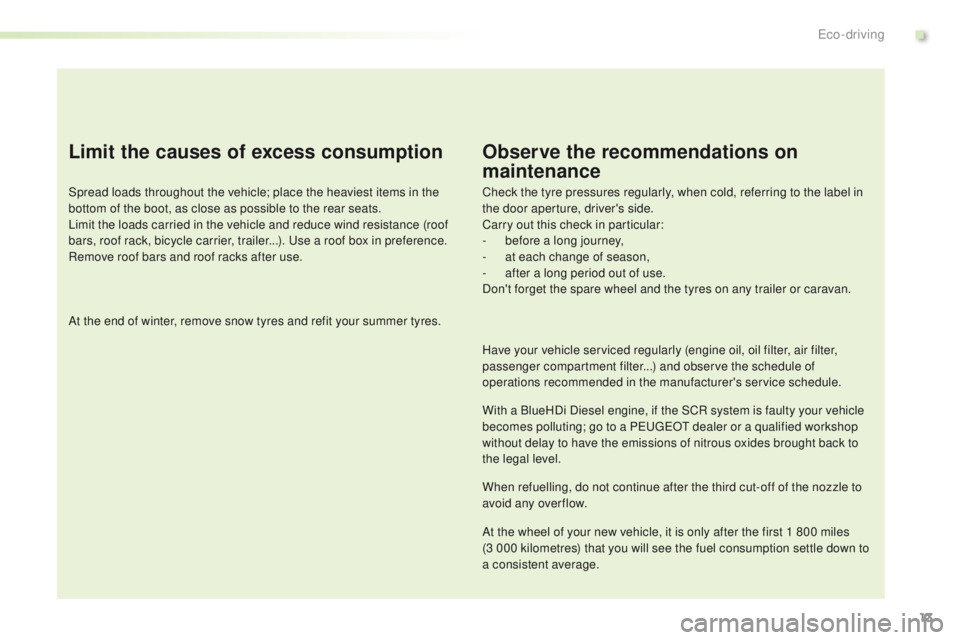
13
2008_en_Chap00c_eco-conduite_ed01-2016
Limit the causes of excess consumption
Spread loads throughout the vehicle; place the heaviest items in the
bottom of the boot, as close as possible to the rear seats.
Limit the loads carried in the vehicle and reduce wind resistance (roof
bars, roof rack, bicycle carrier, trailer...). Use a roof box in preference.
Remove roof bars and roof racks after use.
At the end of winter, remove snow tyres and refit your summer tyres.
Observe the recommendations on
maintenance
Check the tyre pressures regularly, when cold, referring to the label in
the door aperture, driver's side.
Carry out this check in particular:
-
b
efore a long journey,
-
a
t each change of season,
-
a
fter a long period out of use.
Don't forget the spare wheel and the tyres on any trailer or caravan.
Have your vehicle serviced regularly (engine oil, oil filter, air filter,
passenger compartment filter...) and observe the schedule of
operations recommended in the manufacturer's service schedule.
With a BlueHDi Diesel engine, if the SCR system is faulty your vehicle
becomes polluting; go to a PEUGEOT dealer or a qualified workshop
without delay to have the emissions of nitrous oxides brought back to
the legal level.
When refuelling, do not continue after the third cut-off of the nozzle to
avoid any over flow.
At the wheel of your new vehicle, it is only after the first 1 800 miles
(3 000 kilometres) that you will see the fuel consumption settle down to
a consistent average.
.
Eco-driving
Page 113 of 450
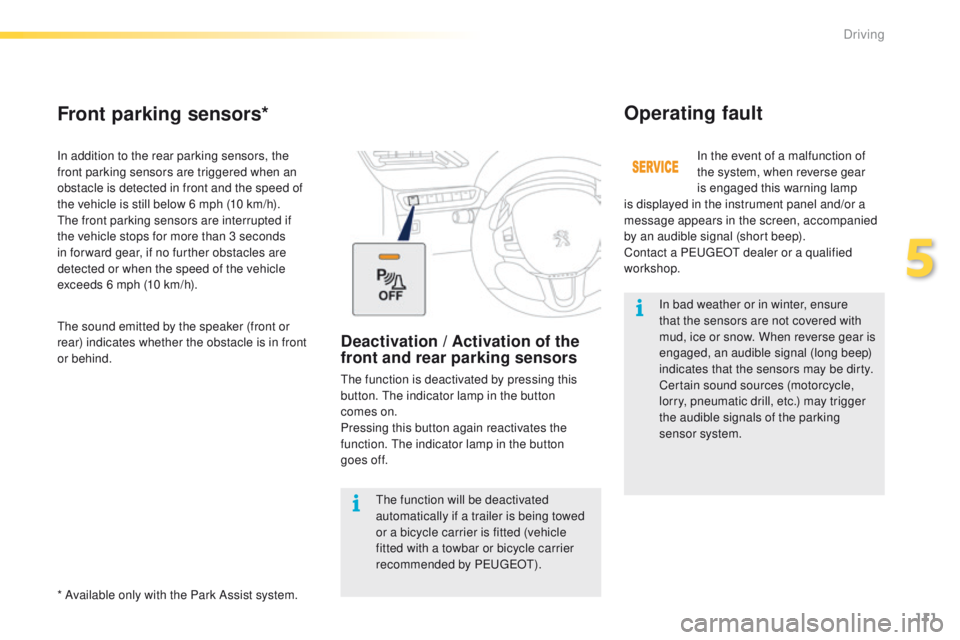
111
2008_en_Chap05_conduite_ed01-2016
In bad weather or in winter, ensure
that the sensors are not covered with
mud, ice or snow. When reverse gear is
engaged, an audible signal (long beep)
indicates that the sensors may be dirty.
Certain sound sources (motorcycle,
lorry, pneumatic drill, etc.) may trigger
the audible signals of the parking
sensor system.In the event of a malfunction of
the system, when reverse gear
is engaged this warning lamp
is displayed in the instrument panel and/or a
message appears in the screen, accompanied
by an audible signal (short beep).
Contact a PEUGEOT dealer or a qualified
workshop.
Operating fault
The function will be deactivated
automatically if a trailer is being towed
or a bicycle carrier is fitted (vehicle
fitted with a towbar or bicycle carrier
recommended by PEUGEOT).
Front parking sensors*
In addition to the rear parking sensors, the
front parking sensors are triggered when an
obstacle is detected in front and the speed of
the vehicle is still below 6 mph (10 km/h).
The front parking sensors are interrupted if
the vehicle stops for more than 3 seconds
in for ward gear, if no further obstacles are
detected or when the speed of the vehicle
exceeds 6 mph (10 km/h).
* Available only with the Park Assist system. The sound emitted by the speaker (front or
rear) indicates whether the obstacle is in front
or behind.
Deactivation / Activation of the
front and rear parking sensors
The function is deactivated by pressing this
button. The indicator lamp in the button
comes
on.
Pressing this button again reactivates the
function. The indicator lamp in the button
goes
off.
5
Driving
Page 118 of 450
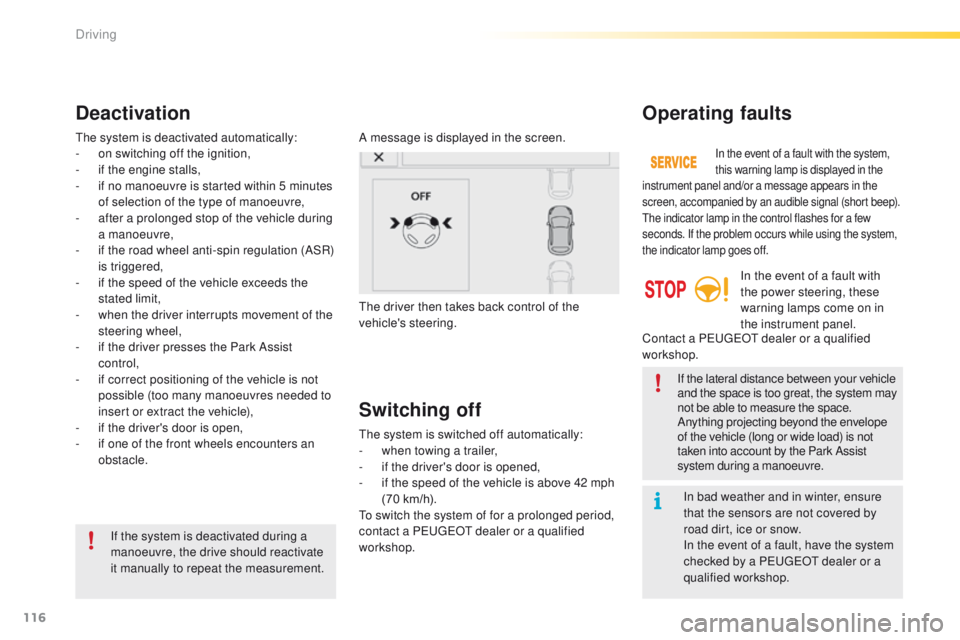
116
2008_en_Chap05_conduite_ed01-2016
In bad weather and in winter, ensure
that the sensors are not covered by
road dirt, ice or snow.
In the event of a fault, have the system
checked by a PEUGEOT dealer or a
qualified workshop.
If the system is deactivated during a
manoeuvre, the drive should reactivate
it manually to repeat the measurement. If the lateral distance between your vehicle
and the space is too great, the system may
not be able to measure the space.
Anything projecting beyond the envelope
of the vehicle (long or wide load) is not
taken into account by the Park Assist
system during a manoeuvre.
Deactivation
A message is displayed in the screen.
The driver then takes back control of the
vehicle's steering.
The system is deactivated automatically:
-
o
n switching off the ignition,
-
i
f the engine stalls,
-
i
f no manoeuvre is started within 5 minutes
of selection of the type of manoeuvre,
-
a
fter a prolonged stop of the vehicle during
a manoeuvre,
-
i
f the road wheel anti-spin regulation (ASR)
is triggered,
-
i
f the speed of the vehicle exceeds the
stated limit,
-
w
hen the driver interrupts movement of the
steering wheel,
-
i
f the driver presses the Park Assist
control,
-
i
f correct positioning of the vehicle is not
possible (too many manoeuvres needed to
insert or extract the vehicle),
-
i
f the driver's door is open,
-
i
f one of the front wheels encounters an
obstacle.
Switching off
The system is switched off automatically:
- w hen towing a trailer,
-
i
f the driver's door is opened,
-
i
f the speed of the vehicle is above 42 mph
(70 km/h).
To switch the system of for a prolonged period,
contact a PEUGEOT dealer or a qualified
workshop.
Operating faults
In the event of a fault with the system,
this warning lamp is displayed in the
instrument panel and/or a message appears in the
screen, accompanied by an audible signal (short beep).
The indicator lamp in the control flashes for a few
seconds. If the problem occurs while using the system,
the indicator lamp goes off.
In the event of a fault with
the power steering, these
warning lamps come on in
the instrument panel.
Contact a PEUGEOT dealer or a qualified
workshop.
Driving
Page 150 of 450
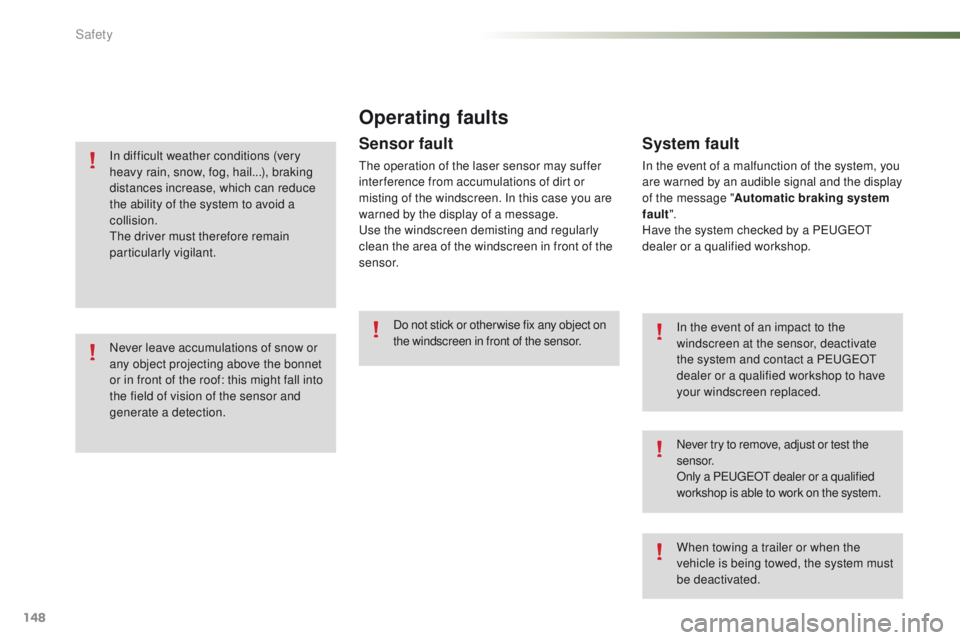
148
2008_en_Chap07_securite_ed01-2016
Operating faults
In the event of an impact to the
windscreen at the sensor, deactivate
the system and contact a PEUGEOT
dealer or a qualified workshop to have
your windscreen replaced.
Never try to remove, adjust or test the
sensor.
Only a PEUGEOT dealer or a qualified
workshop is able to work on the system.
When towing a trailer or when the
vehicle is being towed, the system must
be deactivated.
Do not stick or other wise fix any object on
the windscreen in front of the sensor.
Sensor fault
The operation of the laser sensor may suffer
inter ference from accumulations of dirt or
misting of the windscreen. In this case you are
warned by the display of a message.
Use the windscreen demisting and regularly
clean the area of the windscreen in front of the
sensor.
System fault
In the event of a malfunction of the system, you
are warned by an audible signal and the display
of the message "
Automatic braking system
fault ".
Have the system checked by a PEUGEOT
dealer or a qualified workshop.
In difficult weather conditions (very
heavy rain, snow, fog, hail...), braking
distances increase, which can reduce
the ability of the system to avoid a
collision.
The driver must therefore remain
particularly vigilant.
Never leave accumulations of snow or
any object projecting above the bonnet
or in front of the roof: this might fall into
the field of vision of the sensor and
generate a detection.
Safety
Page 225 of 450
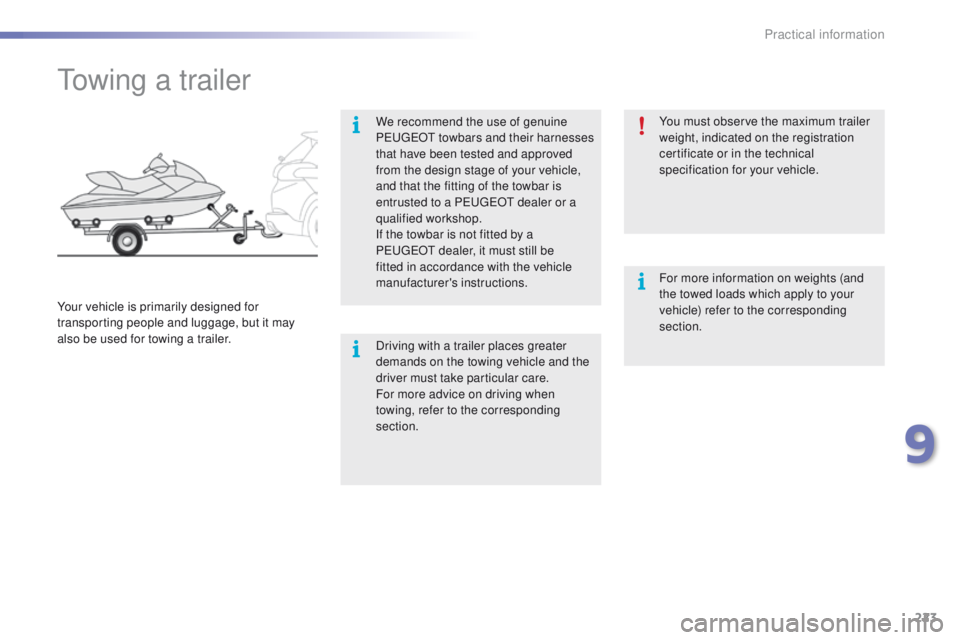
223
2008_en_Chap09_info-pratiques_ed01-2016
Towing a trailer
We recommend the use of genuine
PEUGEOT towbars and their harnesses
that have been tested and approved
from the design stage of your vehicle,
and that the fitting of the towbar is
entrusted to a PEUGEOT dealer or a
qualified workshop.
If the towbar is not fitted by a
PEUGEOT dealer, it must still be
fitted in accordance with the vehicle
manufacturer's instructions.
Your vehicle is primarily designed for
transporting people and luggage, but it may
also be used for towing a trailer. Driving with a trailer places greater
demands on the towing vehicle and the
driver must take particular care.
For more advice on driving when
towing, refer to the corresponding
section.You must observe the maximum trailer
weight, indicated on the registration
certificate or in the technical
specification for your vehicle.
For more information on weights (and
the towed loads which apply to your
vehicle) refer to the corresponding
section.
9
Practical information
Page 226 of 450
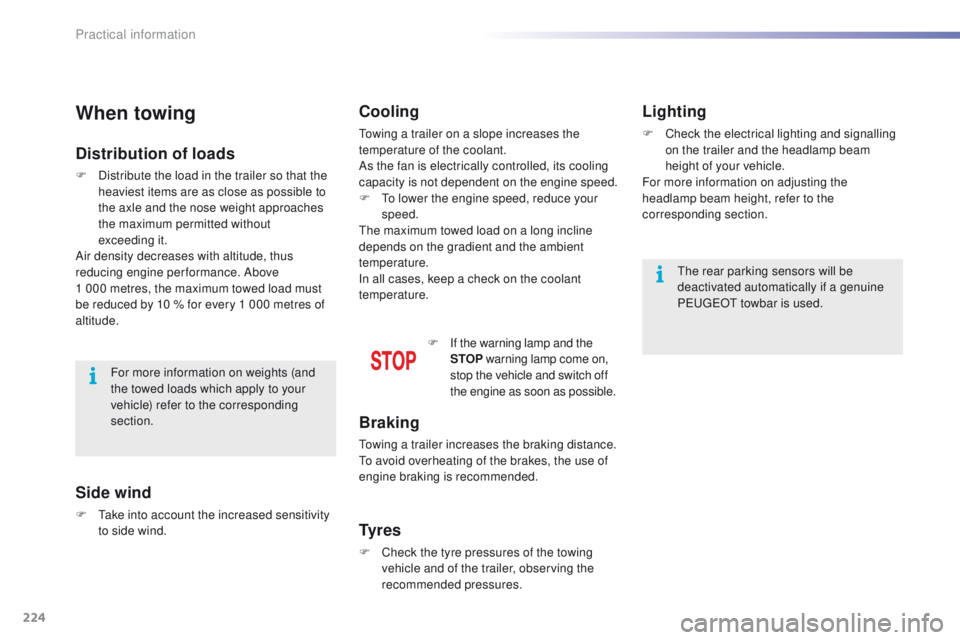
224
2008_en_Chap09_info-pratiques_ed01-2016
When towing
Distribution of loads
F Distribute the load in the trailer so that the heaviest items are as close as possible to
the axle and the nose weight approaches
the maximum permitted without
exceeding
it.
Air density decreases with altitude, thus
reducing engine performance. Above
1
000 metres, the maximum towed load must
be reduced by 10
% for every 1 000 metres of
altitude.
Side wind
F Take into account the increased sensitivity to side wind.For more information on weights (and
the towed loads which apply to your
vehicle) refer to the corresponding
section.
Cooling
Towing a trailer on a slope increases the
temperature of the coolant.
As the fan is electrically controlled, its cooling
capacity is not dependent on the engine speed.
F
T
o lower the engine speed, reduce your
speed.
The maximum towed load on a long incline
depends on the gradient and the ambient
temperature.
In all cases, keep a check on the coolant
temperature.
F
I
f the warning lamp and the
STOP warning lamp come on,
stop the vehicle and switch off
the engine as soon as possible.
Braking
Towing a trailer increases the braking distance.
To avoid overheating of the brakes, the use of
engine braking is recommended.
Ty r e s
F Check the tyre pressures of the towing vehicle and of the trailer, observing the
recommended pressures.
Lighting
F Check the electrical lighting and signalling on the trailer and the headlamp beam
height of your vehicle.
For more information on adjusting the
headlamp beam height, refer to the
corresponding section.
The rear parking sensors will be
deactivated automatically if a genuine
PEUGEOT towbar is used.
Practical information
Page 227 of 450
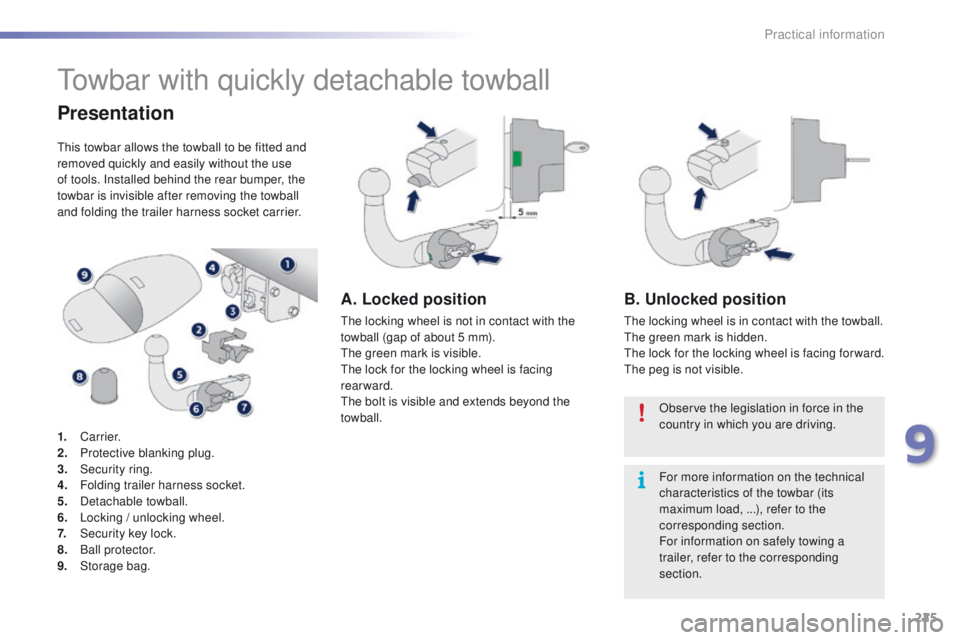
225
2008_en_Chap09_info-pratiques_ed01-2016
Towbar with quickly detachable towball
Presentation
This towbar allows the towball to be fitted and
removed quickly and easily without the use
of tools. Installed behind the rear bumper, the
towbar is invisible after removing the towball
and folding the trailer harness socket carrier.
1.
Carrier.
2.
P
rotective blanking plug.
3.
S
ecurity ring.
4.
F
olding trailer harness socket.
5.
D
etachable towball.
6.
L
ocking / unlocking wheel.
7.
Sec
urity key lock.
8.
Ba
ll protector.
9.
St
orage bag.
A. Locked position
The locking wheel is not in contact with the
towball (gap of about 5 mm).
The green mark is visible.
The lock for the locking wheel is facing
rearward.
The bolt is visible and extends beyond the
towball.
B. Unlocked position
The locking wheel is in contact with the towball.
The green mark is hidden.
The lock for the locking wheel is facing for ward.
The peg is not visible. Observe the legislation in force in the
country in which you are driving.
For more information on the technical
characteristics of the towbar (its
maximum load, ...), refer to the
corresponding section.
For information on safely towing a
trailer, refer to the corresponding
section.
9
Practical information
Page 228 of 450
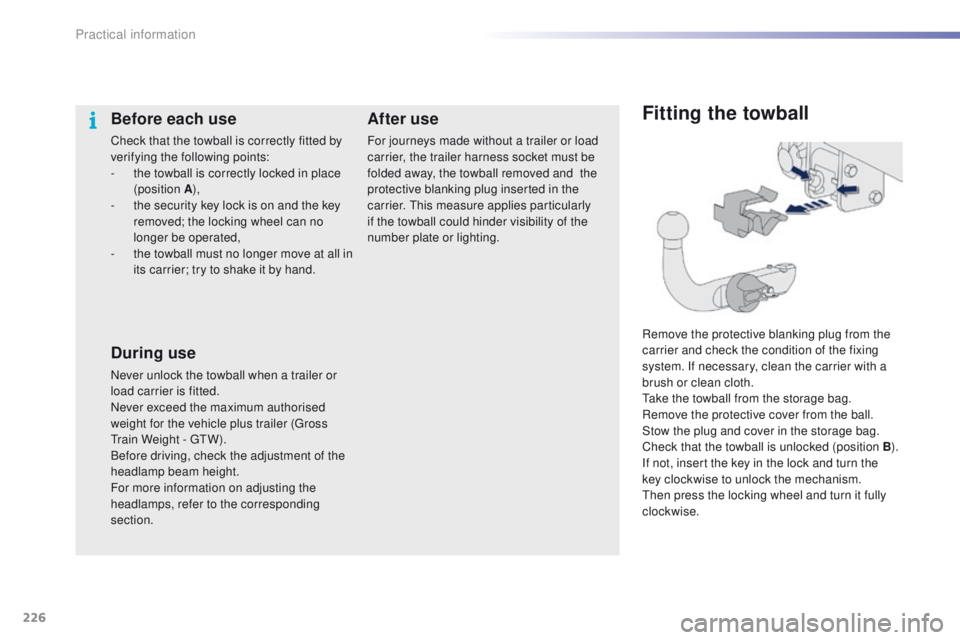
226
2008_en_Chap09_info-pratiques_ed01-2016
Fitting the towball
Remove the protective blanking plug from the
carrier and check the condition of the fixing
system. If necessary, clean the carrier with a
brush or clean cloth.
Take the towball from the storage bag.
Remove the protective cover from the ball.
Stow the plug and cover in the storage bag.
Check that the towball is unlocked (position B).
If not, insert the key in the lock and turn the
key clockwise to unlock the mechanism.
Then press the locking wheel and turn it fully
clockwise.
Before each use
Check that the towball is correctly fitted by
verifying the following points:
-
t
he towball is correctly locked in place
(position A ),
-
t
he security key lock is on and the key
removed; the locking wheel can no
longer be operated,
-
t
he towball must no longer move at all in
its carrier; try to shake it by hand.
During use
Never unlock the towball when a trailer or
load carrier is fitted.
Never exceed the maximum authorised
weight for the vehicle plus trailer (Gross
Train Weight - GTW).
Before driving, check the adjustment of the
headlamp beam height.
For more information on adjusting the
headlamps, refer to the corresponding
section.
After use
For journeys made without a trailer or load
carrier, the trailer harness socket must be
folded away, the towball removed and
the
protective blanking plug inserted in the
carrier. This measure applies particularly
if the towball could hinder visibility of the
number plate or lighting.
Practical information
Page 229 of 450
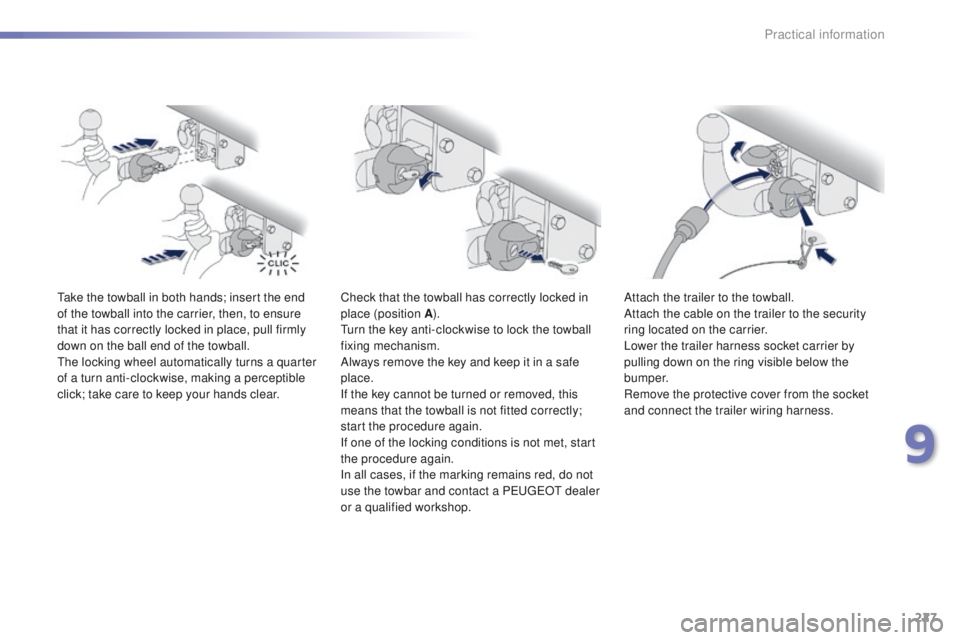
227
2008_en_Chap09_info-pratiques_ed01-2016
Take the towball in both hands; insert the end
of the towball into the carrier, then, to ensure
that it has correctly locked in place, pull firmly
down on the ball end of the towball.
The locking wheel automatically turns a quarter
of a turn anti-clockwise, making a perceptible
click; take care to keep your hands clear.Check that the towball has correctly locked in
place (position A
).
Turn the key anti-clockwise to lock the towball
fixing mechanism.
Always remove the key and keep it in a safe
place.
If the key cannot be turned or removed, this
means that the towball is not fitted correctly;
start the procedure again.
If one of the locking conditions is not met, start
the procedure again.
In all cases, if the marking remains red, do not
use the towbar and contact a PEUGEOT dealer
or a qualified workshop. Attach the trailer to the towball.
Attach the cable on the trailer to the security
ring located on the carrier.
Lower the trailer harness socket carrier by
pulling down on the ring visible below the
b u m p e r.
Remove the protective cover from the socket
and connect the trailer wiring harness.
9
Practical information